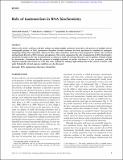Role of tautomerism in RNA biochemistry
Author(s)
Singh, Vipender; Fedeles, Bogdan I.; Essigmann, John M.
DownloadSingh-2015-Role of tautomerism.pdf (1.240Mb)
PUBLISHER_CC
Publisher with Creative Commons License
Creative Commons Attribution
Terms of use
Metadata
Show full item recordAbstract
Heterocyclic nucleic acid bases and their analogs can adopt multiple tautomeric forms due to the presence of multiple solvent-exchangeable protons. In DNA, spontaneous formation of minor tautomers has been speculated to contribute to mutagenic mispairings during DNA replication, whereas in RNA, minor tautomeric forms have been proposed to enhance the structural and functional diversity of RNA enzymes and aptamers. This review summarizes the role of tautomerism in RNA biochemistry, specifically focusing on the role of tautomerism in catalysis of small self-cleaving ribozymes and recognition of ligand analogs by riboswitches. Considering that the presence of multiple tautomers of nucleic acid bases is a rare occurrence, and that tautomers typically interconvert on a fast time scale, methods for studying rapid tautomerism in the context of nucleic acids under biologically relevant aqueous conditions are also discussed.
Date issued
2015-01Department
Massachusetts Institute of Technology. Center for Environmental Health Sciences; Massachusetts Institute of Technology. Department of Biological Engineering; Massachusetts Institute of Technology. Department of ChemistryJournal
RNA
Publisher
Cold Spring Harbor Laboratory Press
Citation
Singh, V., B. I. Fedeles, and J. M. Essigmann. “Role of Tautomerism in RNA Biochemistry.” RNA 21, no. 1 (December 16, 2014): 1–13.
Version: Final published version
ISSN
1355-8382
1469-9001